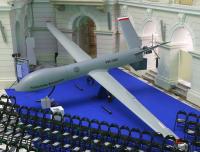PW-100 for 100 Years of the Revival of Warsaw University of Technology
One of the biggest research ventures of Warsaw University of Technology is the PW-100 project. Its aim is to construct a large manned test platform for in-flight testing of various on-board systems, such as mobile radars, thermovision sensors, chemical sensors, antennas, teledetection systems. In the next development phases, PW-100 will be fully unmanned and devoted to military and paramilitary missions. It will be able to complete surveillance, monitoring and fight tasks from the level of 7 km.
The structure of the aircraft was designed by a team of employees, students and doctoral students of the WUT Faculty of Power and Aeronautical Engineering led by professor Zdobyslaw Goraj. – The role of the students must be especially emphasised – without them the work would have been impossible. They are mainly members of student research groups and have been awarded prizes and distinctions in international competitions. These students are our greatest treasure and no company, even the biggest manufacturer, can equal us in this field – the professor said.
The PW-100 project has been divided into three phases:
- phase 1: PW-100A - manned version, MTOW of 600 kg, range of 2000 km and flight endurance up to 10h;
- phase 2: PW-100B - unmanned version, MTOW of 600 kg, range of 6500 km and flight endurance up to 30h;
- phase 3: PW-100C – final unmanned version, MTOW of 1100 kg, range of 8000 km and flight endurance up to 50h.
PW-100A has been designed and manufactured as a test platform for research centres to facilitate in-flight testing of different on-board systems (mobile radars, thermovision sensors, chemical sensors, antennas, teledetection systems and others). Untypical configuration layout of the aircraft results from the plans on its further development – PW-100 will ultimately be used as an unmanned platform, i.e. PW-100B. Moreover, the experience gained during flight testing will facilitate some military unmanned applications of PW-100 for surveillance, monitoring and other missions. The task will be realised in phase 3, i.e. construction of PW-100C.
- Upon completion of in-flight tests, the manned test platform PW-100 will be transferred for serial production to a SME and advertised on the global market. When phases 2 and 3 are completed, PW-100 will have only two competitors in the world – US aircraft PREDATOR by General Atomics (in various versions) and Israeli HERMES 900 by Elbit – said professor Goraj.
Completion of the project has engaged more and more research teams from Warsaw University of Technology, representing various engineering specialisations. The greatest research and construction challenges faced by various units (negotiations are in progress) are:
- project and structure of the aircraft – WUT Faculty of Power and Aeronautical Engineering;
- direct (up to 250 km) and satellite communications, ATOL – WUT Faculty of Electronics and Information Technology;
- teledetection – WUT Faculty of Geodesy and Cartography;
- SAR, FLIR - WUT Faculty of Mechatronics and Faculty of Electronics and Information Technology;
- chemical sensors – WUT Faculty of Chemical and Process Engineering;
- stepper motors, electrical energy supply system, in the future ”Full Electric Aircraft” - WUT Faculty of Electrical Engineering;
- Ground Control Station – WUT Faculty of Automotive and Construction Machinery Engineering.
High innovation of PW-100 lies in its modular design (easy replacement of wings, empennage to be best fitted to the prescribed mission), faster and cheaper in-flight testing achieved by combining the manned and unmanned aircraft versions. Also, the high innovation and originality are clearly visible in the wide spectrum of potential applications - from high altitude atmospheric pollution research, mobile systems of sensors testing to paramilitary and military tasks.








